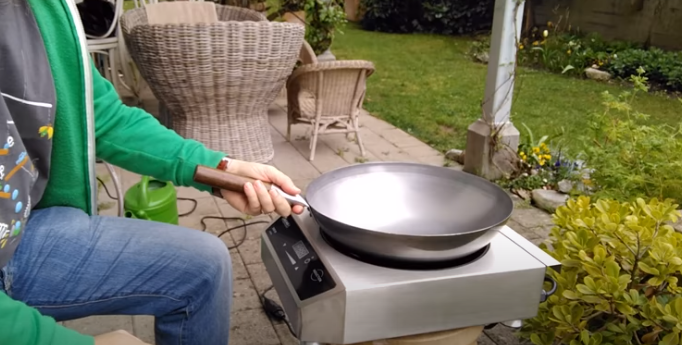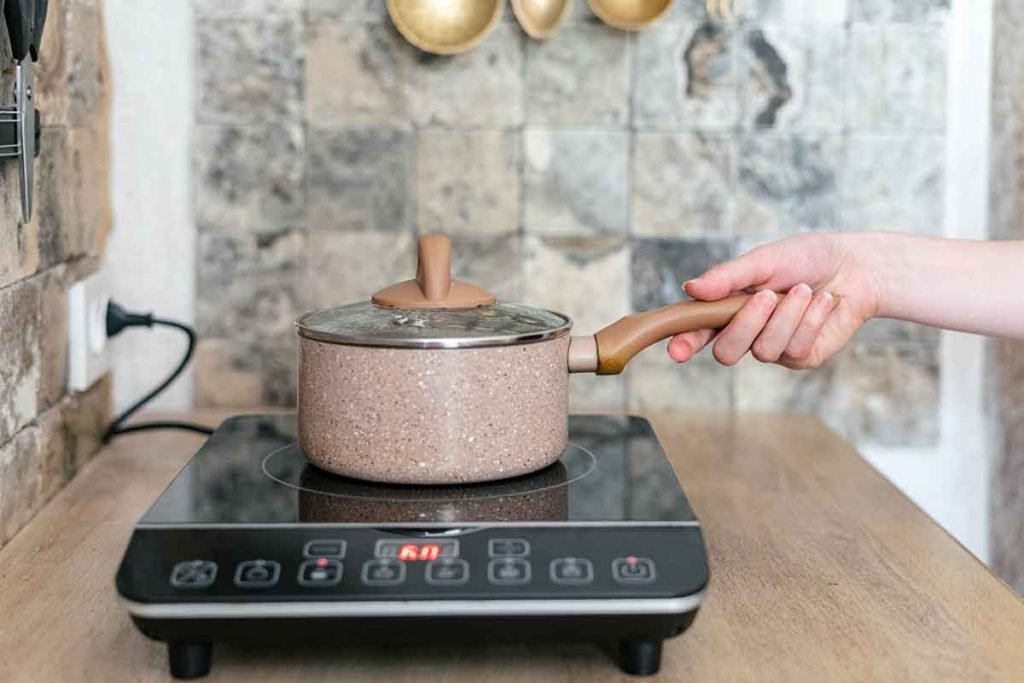Simple answer: Yes, an induction hob can get hot enough to stir-fry.
Before purchasing my first induction hob, I stir-fried on my beloved gas cooker. My mom did the same when I was young. Furthermore, I’d heard countless pros recommend stir-frying with a gas stove. So, the process was etched in my psyche.
As such, upon getting my first induction cooker, I wasn’t ready to stir-fry with it at the drop of a hat. I questioned everything from the get-go, including the appliance’s ability to provide enough heat to prepare my favorite dish, stir-fried chicken. But my doubts were misplaced. Over the years, I’ve realized that preparing delicious stir-fry on an induction hob is extremely possible.
So, Can You Stir Fry on Your Induction Hob?
If you’d like to prepare some stir-fry and wonder if doing it on your induction hob is possible, I have some good news. You can easily prepare mouth-watering stir-fry on the cooker, provided you have the right cookware.
And don’t worry about insufficient heat. I know that the key to making finger-licking stir-fry is high heat. Most importantly, I recommend stir-frying on an induction hob because the average cooker can meet and exceed temperature requirements.
Is stir-frying on an Induction Cooktop as Effective as Using a Traditional Gas Stove?
When it comes to stir-frying, I can proudly declare that my induction hob outshines my time-tested gas stove. Let me support my statement with a few words.
While using my induction cooktop, I can crank up the heat, which gives my food the coveted crisp texture. That doesn’t mean I can’t do the same with the other appliance. But remember, the average induction stove can reach up to 643°F, which is higher than my gas stove’s threshold. So, whenever a recipe calls for elevated temperatures, I go with the induction cooker.
Are there Specific Heat Settings for Stir-Frying on Induction Cooktops?
Some induction hobs have dedicated and labeled heat settings for stir-frying, but most don’t. That said, the best temperature for preparing an unforgettable stir-fry is at least 450°F, and most cooktops can reach and exceed it.
Most importantly, advanced hobs like mine have precise temperature control. So, depending on the recipe I’m trying at a given time, I can set the exact temperature recommended. But some brands don’t support the feature. If yours is the latter category, just stick to the high heat setting, which often starts at around 420°F.
Special Pan to Stir Fry on An Induction Hob
The best item for preparing a spectacular stir-fry is a stir-fry pan. However, you can use just a stir-fry pan for stir-frying on an induction hob. On the contrary, you need induction-ready cookware made from ferromagnetic materials like stainless steel, cast iron, or carbon steel.
A simple trick can help you check if your stir-fry pan is suitable for induction stir-frying. Just grab a fridge magnet and put it on the cookware’s bottom. If it sticks, get ready to start stir-frying immediately. If not, prepare to buy an induction-ready stir-fry pan. What if you’ve developed a special relationship with your pan and aren’t ready to throw it out yet? Don’t worry; there’s another alternative.
My favorite stir-fry pan was gifted to me by my mom, so I’m quite attached to it. Sadly, it’s made of copper and can’t work directly with an induction cooktop. But I still use it. How do I do that, you wonder? To make that possible, I’ve purchased a quality induction plate adapter, which acts as an intermediary between my pan and the cooktop.
Can You Use a Wok on an Induction Stove?

Absolutely! Besides a stir-fry pan, you may also use a wok to prepare memorable treats on an induction hob. But like the former, your wok must be made of an induction-compatible material like carbon or stainless steel. If not, it should have a magnetic base.
Reputable manufacturers have perfected the art of making induction-ready material to a T, so pay close attention. For instance, although an item made entirely of aluminum isn’t induction compatible, you may come across an aluminum wok with an iron insert in its base. Since iron is magnetic, the insert should enable the aluminum wok to function seamlessly with an induction hob.
Tips For Stir Frying on An Induction Hob
Preparing stir-fry isn’t as easy as it sounds. I’ve discovered that the hard way. I wish I could count the times I’ve toiled on my cooktop preparing my favorite delicacy, chicken stir-fry, only to end up with a soggy, rubbery disappointment. But that happened in the past. Today, I can prepare a perfect stir-fry with my eyes closed, figuratively. Allow me to share a few tips.
Tip #1: Choose Prime Beef
Stir-frying is a quick process that only takes a couple of minutes. As such, it makes preparing beef stir-fry very tricky. Remember, if undercooked, beef can be tough and chewy. On the contrary, if you extend the cooking time, other ingredients might get overcooked, lose flavor, or burn.
To avoid disappointment, I use prime meat for beef stir-fry. You should do the same since prime beef is tender and easy to cook. Moreover, to facilitate rapid cooking, cut the meat into bite-size pieces.
Tip #2: Velvet Chicken Pieces
My ability to prepare unmatched chicken stir-fry has awed many. What’s my secret? Besides using the right ingredients, constantly checking for doneness, and using premium chicken, I velvet the meat before throwing it into the wok.
By velveting, I always rest assured my chicken will come out with a silky texture and a moist, inviting allure. But this hack doesn’t apply to chicken exclusively. You can also velvet pork, shrimp, or beef before stir-frying.
Tip #3: Preheat the Cookware
Undoubtedly, the only way to stir-fry delicious dishes is by going in hot and quick. With hot cookware and quick movements, you can scorch out your ingredients’ aromas, brighten the flavors, and avoid drying out any cooking meat.
With that in mind, preheat your stir-fry pan or wok before you start stir-frying. Simply place the cookware on the cooktop, fire up the hob, and wait 2-3 minutes. Use medium heat. Don’t let the empty pan or wok sit on the cooktop for too long because it will overheat, which can cause countless complications, including burnt, bitter-tasting ingredients.
Tip #4: Don’t Bang Cookware Against the Cooktop
If you’ve ever seen experts stir-frying food, you know they constantly move their cookware and toss ingredients. Why? Tossing enables them to mix all ingredients in a few quick moves. It’s also indispensable in achieving the infamous wok hei flavor that makes stir-fry delicious.
If you’d like to try this popular technique, ensure you don’t do it too close to your induction hob. That is crucial because you might bang the cookware against the cooktop and shatter the glass cover.
What Can You Not Cook on An Induction Cooktop?
The good news is you can prepare most stir-fry dishes on an induction hob. The bad news is there are several limitations:
Some stir-fry recipes demand flaming, like flambe stir-fry chicken chunks with veggies. Sadly, induction hobs don’t produce open flames. And, although igniting the food with a sizable fireplace match is possible, it can damage your cooktop.
Preparing large quantities of stir-fry on an induction hob can be tricky since it demands large-sized cookware. But I don’t recommend stir-frying with a wok or pan bigger than your cooker’s eye because it encourages uneven heating and makes tossing impossible. On the other hand, using smaller cookware will cause overcrowding and ruin your stir-fry.
Final Words
When it comes to stir-frying, my induction hob has proven to be better suited to the role than a conventional gas stove for several reasons. First, with it, I can use extreme temperatures to prepare crisp, juicy treats. Moreover, the cooktop allows me to set the exact temperature I’d like to use at any given moment and helps me cook faster.
I have used my induction cooktop to prepare memorable culinary delights, and now I’ve passed on the baton to you. If you stick to everything outlined here, you’ll be a stir-fry guru in no time.
Here’s to conquering the kitchen and preparing delicious stir-fry!
FAQs
Can Induction Cooktops Generate Enough Heat for Stir-frying?
Absolutely. Induction cooktops utilize electromagnetic fields to instantly and intensely heat cookware, enabling them to produce the high heat levels stir-frying requires.
What Cookware is Best for Stir-frying on an Induction Cooktop?
A good cookware has a flat, magnetic base that makes good contact with the induction surface, like stainless steel, cast iron, or induction-compatible non-stick pans.
Do I Need Special Techniques for Stir-frying on an Induction Cooktop?
Stir-frying techniques are largely the same, but induction’s rapid, precise heat control requires quick adjustment of temperatures as needed while cooking.
Can I Achieve the Wok Hei (Breath of the Wok) Flavor on an Induction Cooktop?
Replicating the intense wok hei flavor from traditional wok burners is challenging on induction. But preheating adequately can still produce delicious stir-fry flavor.
How Does the Speed of Induction Cooking Impact Stir-frying?
The rapid heating of induction cooktops is extremely beneficial for stir-frying, as it cooks ingredients quickly over high heat to better retain nutrients and flavors.
Can I Use a Round-bottomed Wok on an Induction Cooktop?
Round-bottomed works won’t work well and can be unstable on flat induction surfaces. Opt for induction-compatible wok pans designed for stability.
How Do I Ensure Even Cooking When Stir-frying on Induction?
Frequently stirring and preheating cookware helps ensure consistent heat distribution and thorough, even cooking.



